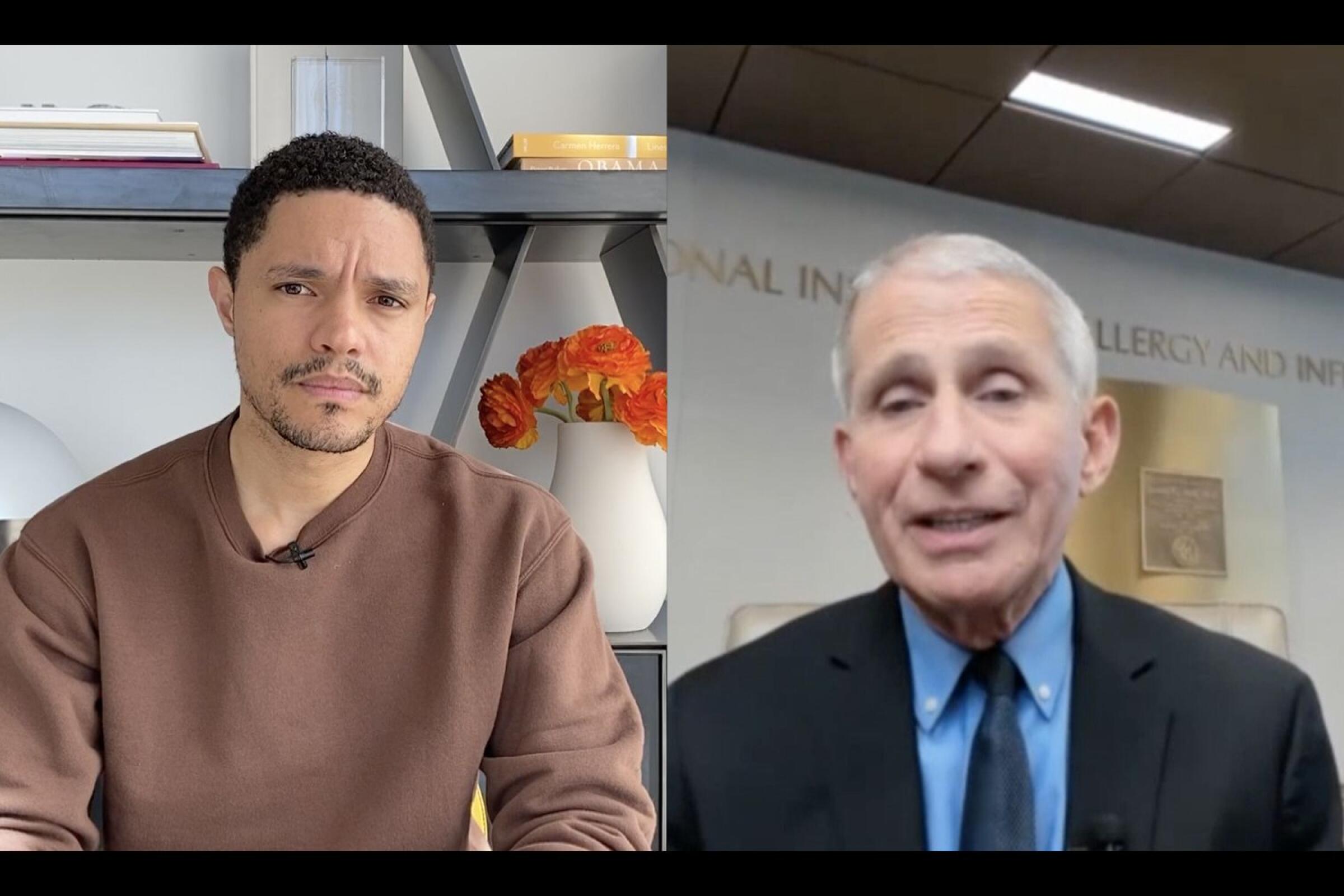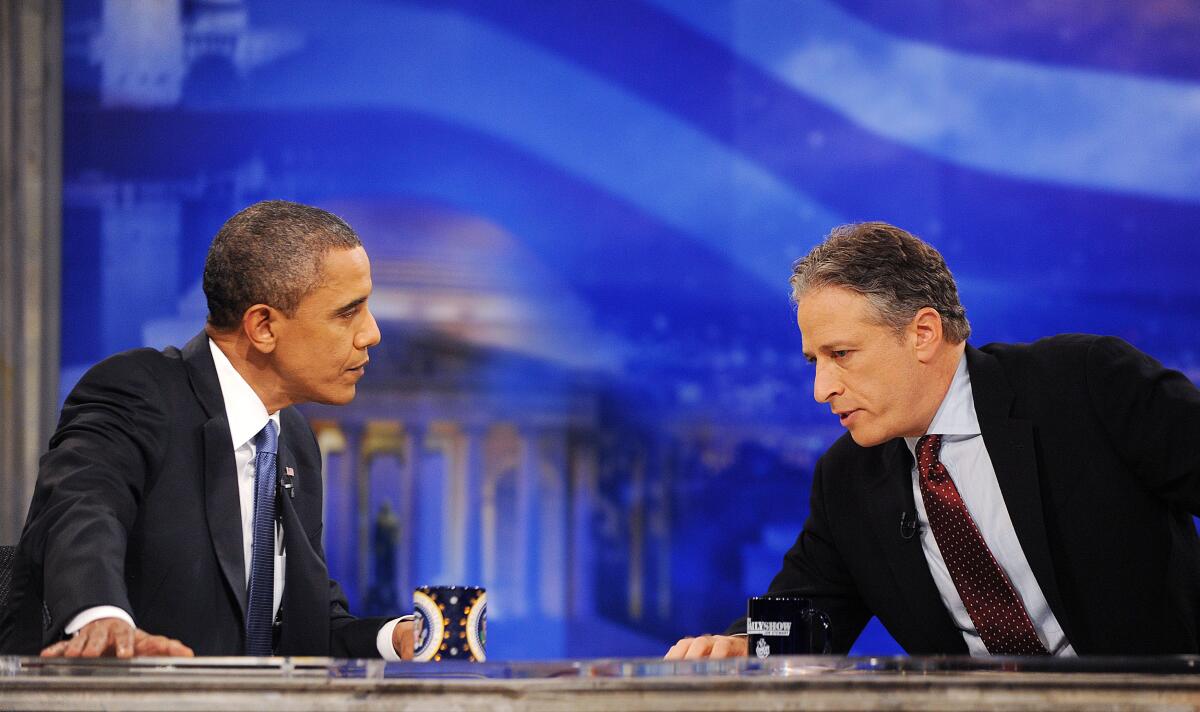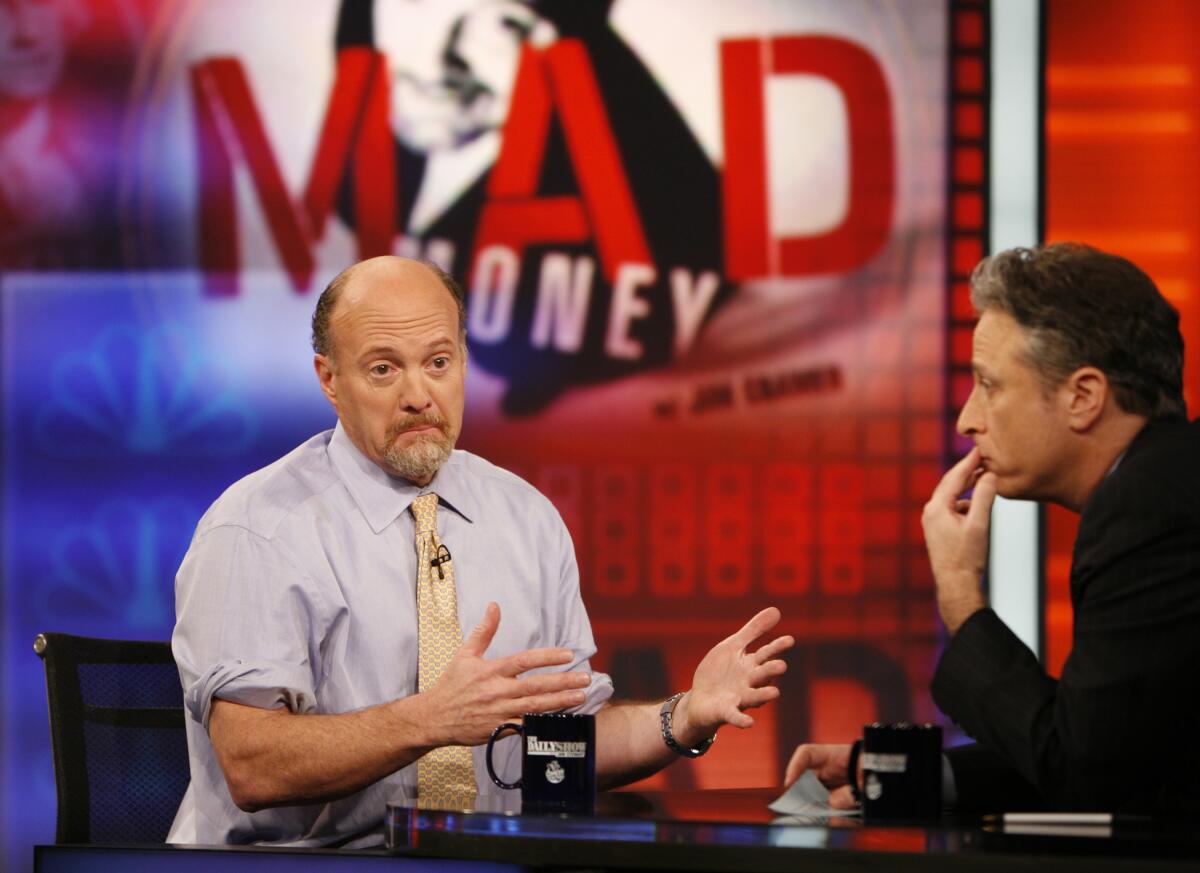The complete guide to home viewing
Get Screen Gab for everything about the TV shows and streaming movies everyone’s talking about.
You may occasionally receive promotional content from the Los Angeles Times.

When “The Daily Show,” conceived as a satirical late-night talk show, first hit the airwaves on July 22, 1996, with original host Craig Kilborn, the show welcomed no guests.
In the 25 years since, it’s become a vital voice in the late-night landscape in part because it’s a site for intriguing conversations with the well-known, the hardly known and the completely unknown in the worlds of entertainment and politics, and everywhere in between.
We look back at some of the notable guests who’ve passed through “The Daily Show” over the years, focusing on the show’s higher-profile eras under Jon Stewart and his successor, Trevor Noah — with insights from executive producer and showrunner Jen Flanz, as well as producers Beth Shorr and Shawna Shepherd, who handle booking on the show.

Barack Obama has appeared on “The Daily Show” as a senator, a presidential candidate, the U.S. president and former president.
“I do worry about the hype — the only person more overhyped than me is you,” he told Stewart in his first appearance, as a senator from Illinois, in November 2005. He’d sit with Stewart six more times — and they weren’t all favorable appearances.
His first visit as president in October 2010, after a tumultuous 18 months in office and with the midterm elections in view, resulted in a peppery three-part interview in which Obama defended his achievements as Stewart expressed his disappointment in the Obama administration over its “timid” legislation on healthcare.
“Jon, I love your show. but this is something where I have a profound disagreement with you,” Obama said, calling Obamacare a crowning achievement of his presidency. “This notion that healthcare was timid — you’ve got 30 million people who are gonna get healthcare because of this.”
Obama’s first appearance under Noah’s tenure came at the end of 2016, in the final days of his presidency. Noah had met Obama at the 39th Kennedy Center Honors just months before and implored Shepherd to try to secure the president as a guest before his term was up.
“I was asked to follow up with my contacts at the White House after that ... and I happened to be in labor at the time, but I continued with the call, and I’m glad I did because we were able to book the interview that day,” Shepherd said. “But I never told the White House team that I was in labor. I felt weird. But we had been trying for so long, I wasn’t going to give up.”

It was Noah’s first remote interview — taking place inside the White House — and would be critical in establishing the host, who was still being measured against Stewart’s imposing shadow.
The two discussed Russia’s meddling in the 2016 election, how Obama navigates racism, and the future of Obamacare. The crew was limited because the interview took place in a small room in the West Wing. The show’s editors also worked on site in D.C. for a quick turnaround to get the interview ready for that night’s episode.
“It took much longer than we expected to edit the interview,” Flanz said. “We ended up missing our train and missing all the flights. We wound up staying in D.C. that night because we just got the show on the air, at 11 p.m. We were like, ‘Forget it, we’re not going to drive back.’” I slept in the dress I met Obama in.”

Conservative political commentator Tomi Lahren rose to prominence during the 2016 election through a series of provocative viral videos as host of “Tomi” on Glenn Beck’s conservative network, the Blaze, in which she lambasted the Black Lives Matter movement and Colin Kaepernick’s activism.
And Noah wanted to invite her on the show.
“I think he saw her out in the zeitgeist and had wanted to know, like, ‘Why is she saying this?’ and wanted her to elaborate on her opinions,” Shorr said, “as opposed to just like dropping a clickbait sort of bomb-thing. [He] wanted to try to come to an understanding of where she was coming from.”
There was some internal discussion about whether they would be recklessly giving a platform to Lahren’s incendiary views or presenting an illuminating conversation with someone with opposing viewpoints. Ultimately, she was booked for an appearance in December 2016 in what became one of Noah’s most talked-about interviews, with some praising it as a high point that was reminiscent of Stewart’s legacy, while others called it a disgrace.
Noah did a lot of prep for the conversation, Shorr said, making sure he was clear on all of Lahren’s talking points. (That involved Shorr and some of the show’s writers reviewing footage and reading transcripts of Lahren’s commentary.)
Noah kicked off the segment by asking Lahren: “Why are you so angry?” before launching into a lengthy debate on policy, recently elected President Trump, and race. When the conversation turned to Kaepernick, Lahren said she didn’t believe the quarterback’s decision to kneel during the national anthem was “the right way” for him to protest — prompting Noah to press her on her logic.
“What is the right way?” he said. “So here is a Black man in America who says, I don’t know how to get a message across. If I march in the streets, people say I’m a thug. If I go out and I protest, people say that it’s a riot. If I bend down on one knee, then it’s not [the right way].”
“I think that we knew it was going to be a tough interview,” Shorr said. “But I don’t think that we thought it was going to blow up online.”
Added Flanz: “I feel like it was a big turning point for us, in getting guests [during Noah’s tenure]. People really saw the kinds of conversations that [Noah] wanted to have, even with people that are just coming out to talk about a movie or something — really getting into these in-depth conversations. So it was a pretty big moment, in terms of people seeing who Trevor is and who he was becoming.”

Remember back to late March 2020, when the uncertainty and fear of a pandemic in the early days of its grip on the U.S. seemingly intensified by the hour. Dr. Anthony Fauci, the director of the National Institute of Allergy and Infectious Diseases, quickly emerged as a trusted voice. And “The Daily Show” was his first stop on the late-night circuit.
Fauci’s team did the reaching out to “The Daily Show,” according to producers.
“Our understanding was they wanted to reach our young audience,” Shepherd said.
The program was a week into producing episodes remotely from home — under the title “The Daily Social Distancing Show With Trevor Noah” — and producers, like many of us working from home, were contending with technical challenges.
“It was a long interview — they talked for, like, 20 minutes,” Flanz said. “Trying to edit that down in time to get it on the air, it was a very close call. And if you go back and watch it now, the video quality is not great. Our editor who worked on it still wishes they had another two hours. But there were definitely nerves of, ‘Wow, we landed this huge interview and we might not get it.’ That was scary. The edit was rocky because we had just started doing shows this way. It never got to where we’d want it to be. ... There were technical glitches galore in that interview.”
During the conversation, Fauci described the virus as “insidious” and stressed the importance of social distancing and frequent hand-washing: “It’s a respiratory-borne illness that easily spreads from person to person but that has a high degree of morbidity and mortality,” he said. “And unfortunately that’s the worst nightmare you could have, to have something like that.”
Meanwhile, Noah asked the sort of questions we all were asking about the elusive virus: whether younger people are immune to it, if it’s safe to touch packages, how long coronavirus hangs in the air.
“We were holed up in our apartments and our homes, and we were scared,” Shepherd said. “We finally had this expert on, so Trevor was not only thinking of our viewers, but he was asking as a legitimately concerned human being.”

Much like Stewart helped introduce Elizabeth Warren to a wider audience — even before she expressed political aspirations —Noah has continued the tradition of tracking the evolution of a rising political figure.
When Georgia’s Stacey Abrams made her debut on “The Daily Show” in 2018, to promote her book “Minority Leader: How to Lead From the Outside and Make Real Change,” the Democrat was the first Black woman to run for governor as a major-party nominee in any state.
Noah asked Abrams how she felt about the focus on the history-making aspect of her run for governor, rather than what platform she was running on.
“I think sometimes there is a Crayola version of policymaking that happens where they do focus on color,” said Abrams. “My mission is to talk about issues, to talk about education and to talk about why it is so critical that we create jobs for everyone that pay a good wage, to talk about expanding access to Medicaid so poor people don’t get sick in Georgia.”
Her eventual narrow defeat in the race didn’t stop her from fighting for equal voting rights in the state and beyond.
“She’s just a really inspiring political figure,” Shepherd said. “We saw her just become an even bigger and bigger political figure and activist. We look back and we’re grateful that we had her on early. Because she’s just the type of person that we want to showcase on the show.”
And although Warren has talked about the nerves she had ahead of her first appearance on the show — which included bouts of vomiting — producers said Abrams didn’t seem as fazed by her inaugural visit.
“She’s a Fulbright scholar,” Shepherd said.

Greta Thunberg, the young climate change activist, was on producers’ radar after her impassioned speech at the World Economic Forum in Davos, Switzerland, in 2019.
While Thunberg was in New York City in September 2019 to speak at the U.N., she made “The Daily Show” her only late-night appearance to promote the Global Climate Strike. And, like the true teenage climate activist that she is, she opted to travel by boat — a 15-day journey.
“Even though she wasn’t in the U.S., I just started reaching out and trying to get in contact with her,” Shepherd said. “Fast-forward, we’re getting closer to September, she’s gonna sail to the U.S. [Before that], we kept joking — I said, she’s not going to fly so I don’t know when she’s ever going to come to the U.S. I don’t know how she’s gonna get here.”
In an illuminating moment in the conversation, Noah asked Thunberg if she sensed a difference in how Sweden and the U.S. viewed the climate crisis.
“I would say yes,” Thunberg said. “Because here, it feels like it is being discussed as something you believe in or [do] not believe in. And where I come from, it’s more like, it’s a fact.”
“It was a big deal,” Shepherd said. “Trevor really wants to have people on the show and showcase their activism and what they care about. And she’s the perfect example of that.”

It was a notable enough conflict in “The Daily Show” canon to warrant its own Wikipedia page. In the lead-up to his now-famous 2009 interview with CNBC’s “Mad Money” host Jim Cramer, Stewart had been making weeklong jabs at the financial news network and some of its hosts, including the stock market pundit, for their deferential coverage of Wall Street in the wake of the 2008 financial crisis.
Cramer’s 15-minute appearance is best classified as a skilled takedown, with Stewart pummeling the financial analyst for being too chummy with bankers, using clips of Cramer’s questionable takes against him: “I understand you want to make finance entertaining. But it’s not a f— game,” Stewart tells Cramer at one point.
“I expected a cordial discussion,” Cramer later said in an interview for New York Times Magazine. “They promised they wouldn’t use any clips, and they lied.
“I should have known this was coming because of how vicious Stewart had been all week,” he said, “but I really thought it was just going to be a friendly show.”
As Flanz remembers it, Cramer’s visit entailed a copious amount of prep work that they didn’t typically do for interviews.
“It was the first one I remember us prepping footage for — like, having tape ready in the control room — like, ‘You said this. You said this. Do you remember when you said this?’” said Flanz, who had roles as supervising producer and coordinating producer during Stewart’s run. “And our director [was] calling the rolls on the fly as Jon would say a key word, and then when Stewart said ‘roll to 12,’ I was in the control room for that and I was like, ‘OMG’ [with a shriek]. The tactical part of making sure we had the right clip ready — it was really tense.”
As for Cramer’s claims that producers promised no clips would be used, Flanz says: “We never make promises like that.”

Not only was Bill O’Reilly a frequent target of ridicule on “The Daily Show” during the Stewart era, the former Fox News host was also a frequent guest, with his first appearance in October 2004. In fact, O’Reilly and Stewart appeared on each other’s show’s many times during their respective on-air runs, often sparring with an air of respect. The O’Reilly-Stewart friendly feud even led to a mock presidential-style debate in 2012 to raise funds for charity.
But with some hindsight, Stewart has reflected on O’Reilly’s visits with regret. In a recent New York Times article, he characterized it as “the worst legacy of ‘The Daily Show.’”
“Those moments when you had a tendency, even subconsciously, to feel like, ‘We have to live up to the evisceration expectation.’” he said in the interview. “We tried not to give something more spice than it deserved, but you were aware of, say, what went viral. Resisting that gravitational force is really hard.”
“I know that Jon feels that way now about it,” Flanz said, “but I think, at the time, it seemed like somebody that we should be having a conversation with because Jon was challenging him on his [O’Reilly’s] views and what he was saying on the air — it felt important.”
The complete guide to home viewing
Get Screen Gab for everything about the TV shows and streaming movies everyone’s talking about.
You may occasionally receive promotional content from the Los Angeles Times.